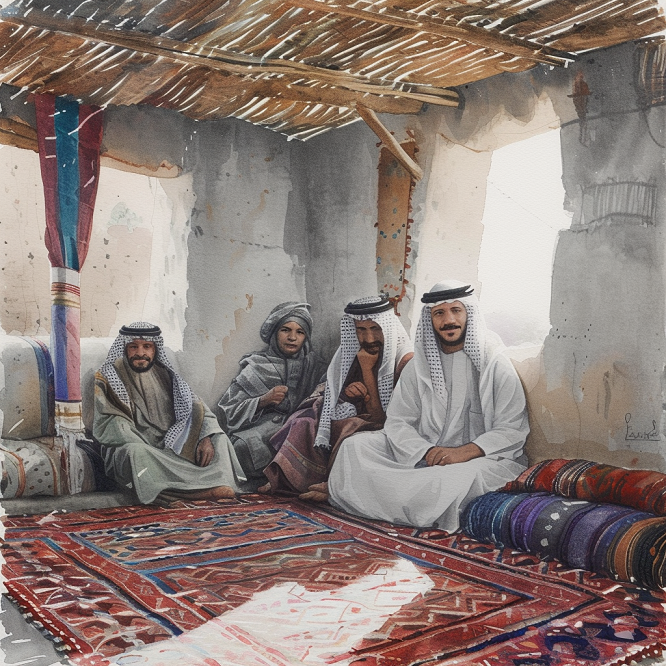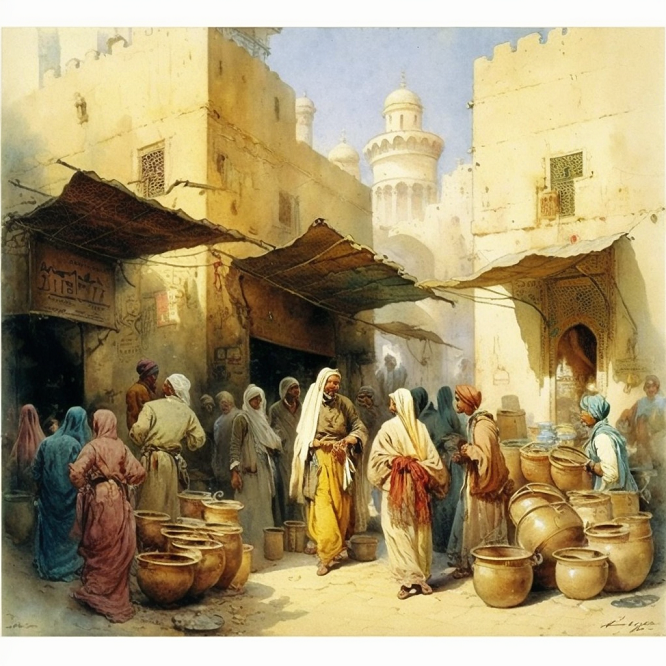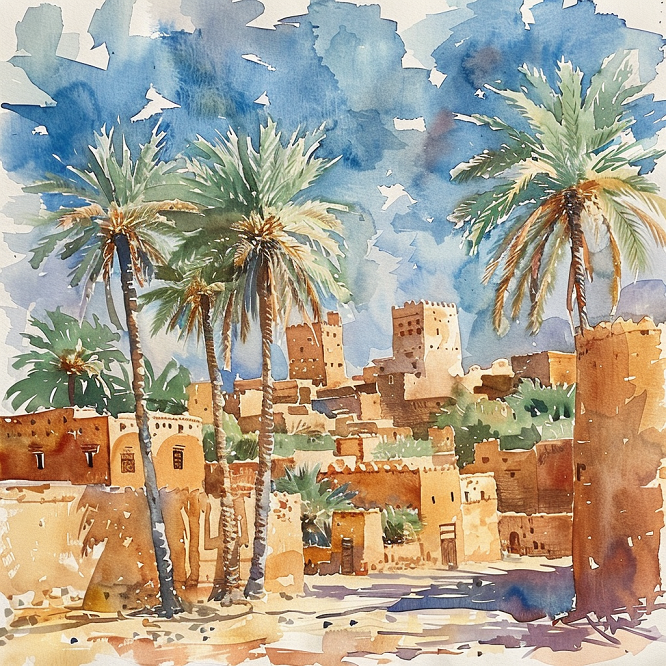Lady Anne Blunt’s travel memoir, “Pilgrimage To Nejd,” , one of her most famous books, offers a fascinating glimpse into her experiences during her journey in Nejd. As the daughter of Lord Byron and wife of Wilfrid Scawen Blunt, Lady Anne Blunt’s observations and encounters with the people of Nejd provide valuable insights into the cultural, social, and political landscape of the region.
Encounters and Initial Experiences in Nejd
During her sojourn in Jawf, Lady Anne Blunt and her company found themselves lodged with a man named Nassr and his family. Nassr, whose most notable feature was his unrefined simplicity, mirrored many attributes of “a humble Scottish laird,” a parallel that Blunt eloquently constructs in her account. His family, the Ibn Aruks, however, led an aesthetically unremarkable existence as town-dwellers.
While their lifestyles and possessions did not provoke passionate inspiration, what they lacked in material elegance, they more than compensated for in their family fabric and interactions. Each family member’s unique identity contributed a different hue to the colour palette, painting a picture of the intricacies and vibrancies of Nejd society. From Nassr’s immediate progeny, his sons, to his extended family comprising of his cousin Jazi and her daughters, a complex and interconnected web of relationships was laid bare for Lady Anne Blunt to seek inspiration.
One of the more intriguing revelations was the unique historical connection between a prominent figure, Mohammed, and the Ibn Aruks. This bond, rooted in a hundred-year-old blood feud, seamlessly connected historical events to the everyday lives of this local family.
In addition to these relational complexities, Blunt carefully tracked the traveling and settlement history of the brothers of Ali ibn Aruk. This added to the depth of the family dynamic, with each journey scribed into the shared narrative, contributing towards an expansive family chronicle, oftentimes giving an impression of the collective nomadic inclination of the Nejd populace. Through the lens of Lady Anne Blunt, the intricate family tree of the Ibn Aruks provided a microcosm of Nejd society, rich in tradition and vested in family bonds that seem to thread through every aspect of daily life.
Ali ibn Aruk, was one of the three brothers who, in consequence of a blood feud, or, as Wilfrid thinks more likely, to escape the Wahhabi tyranny of a hundred years ago, left Aared in Nejd, and came north as far as Tudmur, where Ali married and remained. Another brother, Abd el-Kader ibn Aruk, had stopped at Jof, settled there, and became Nassr’s grandfather. As to the third, Mutlakh, the descendants of the two former know nothing of his fate, except that, liking neither Tudmur nor Jof, he returned towards Nejd. Some vague report of his death reached them, but nobody can tell when or how he died. Nassr came from J6f to Meskakeh not many years ago.
Pilgrimage To Nejd: Lady Anne Blunt

A Proposal for Matrimony and its Ramifications
In an unexpected twist during Lady Anne Blunt’s stay with Nassr’s family, a new plot thread unravelled when Mohammed, the Blunt’s travel guide, expressed a sudden desire to seek a wife amongst the female members of the Ibn Aruks lineage. This unexpected development enlivened Blunt’s narrative, weaving it with layers of anticipation and apprehension.
Mohammed, with his historical ties to the family, revealed a particular interest in Muttra, Jazi’s daughter. This, in itself, opened another avenue of insight into the practice of matrimonial alliances in the context of Nejd culture. Mohammed’s choice of seeking a bride from the family with which he had a centuries-old connection underscored the importance attached to familial ties and the weightage given to shared lineage.
The complexities and negotiations surrounding the marriage proposal allowed Blunt to probe deeper into the intricacies of Nejd social fabric. The negotiation process was not confined to mere material bargaining but also encompassed ethereal matters such as the honour of the family, societal reputation, and affirmation of shared history among others. The marriage proposal thus became a crucible in which many aspects of the cultural, social, and traditional attributes of Nejd were melded together.
Negotiation for Muttra’s hand in the union also shed light on the role of women in the socio-cultural configuration of Nejd. While the women appeared to be at the receiving end of matrimonial negotiations, their acquiescence or dissent played a significant role in the final decision. Thus, in a seemingly male-dominated society, women’s silent power shone through in times of important family decisions, ensuring their place in the societal hierarchy.
The arduous process of negotiating for Muttra’s hand in marriage included detailed discussions on matters such as the dowry. For instance, there was significant disagreement over the dowry, with the families’ honour tangibly tied to the size of the dowry. Lady Anne Blunt meticulously recorded this intense negotiation process, which ultimately ended in a family council which agreed to settle on a dowry of fifty Turkish pounds.
Mohammed has all along declared that he must be guided by my opinion. I shall know, he pretends, at once, not only whether Muttra is pretty, but whether good-tempered, likely to make a good wife. He had been calculating, he said, and thought forty pounds would be asked as her dower. It is a great deal to be sure, but then she was really ” asil,” and the occasion was a unique one—a daughter of Jazi!—a niece of Merzuga!—a girl of such excellent family !—an Ibn Aruk ! and Ibn Ariiks were not to be had every day !—forty pounds would hardly be too much. He trusted all to my judgment—I had so much discernment, and had seen the wives and daughters of all the Anazeh Sheykhs; I should know what was what
Pilgrimage To Nejd: Lady Anne Blunt
The proposal for matrimony and its consequences brought to light the integration of familial ties, historical traditions, and societal values in shaping the life events of the Nejd community. Through Lady Anne Blunt’s recounting of these events, readers are offered an in-depth understanding of the poignant blend of social norms and cultural sentiments that underscore the regressions and progressions of everyday life in Nejd.
Politics & Governance in Nejd
In the landscape of Nejd traversed by Lady Anne Blunt and her company, politics and governance were not abstract, detached entities, but rather implicit components of their everyday encounters and experiences. Astoundingly aware of the subtle undercurrents of influence, power, and hierarchy inherent within Nejd, Blunt skilfully intertwines the political dimension of their journey with their ongoing experiences.
Throughout their journey, Lady Anne Blunt and her company traversed various territories, each under the rule of different authorities. The uniqueness of each governor’s authority, their style of governance, and their interactions with the travellers made each encounter a cornucopia of insights into the customs, attitudes, and mindset of those in charge. In this aspect, the ruler’s attitudes, their approach to governance, and their philosophy of power painted a vivid picture of the socio-political climate of Nejd.
One such encounter with a governor – Johar – tosses a significant light on the convoluted tapestry of Nejd politics. The meeting involved Johar extending his assistance to guide the travellers further in their journey, showcasing the inherent culture of exchange and reciprocity in Nejd society.
As they moved from one governor’s area of authority to another, they were often required to renegotiate their position, purpose, and relationship. This act of constant negotiation and adaptation lent depth to their experiences, highlighting the inherent political nuances in their travel through Nejd, and the dynamic interplay of power, allegiance, and authority exposed through their encounters.
When we were summoned again to Johar’s presence, this time on the house-top, we found …. our journey being discussed as a settled matter. Carpets were then spread, and we all sat down on the roof and had breakfast, boiled meat on rice, with a sharp sauce to pour over the rice, and then after the usual washings and elhamdulillahs we retired, extremely- pleased to get away from the flies and the hot sun of Johar’s roof; and not a little thankful for the good turn things had taken with us. As Wilfrid remarked, when we were well on our mares again and riding home, Johar was just the picture of a capricious despot, and one who, if he had been in a bad humour, might have ordered our heads off, with no more ceremony than he had ordered breakfast.
Pilgrimage To Nejd: Lady Anne Blunt
The direct interactions of Lady Anne Blunt with these governors and other persons of authority also give a glimpse into her ability to engage with power structures from a unique vantage point as a foreign woman traveller. Her narrative underscores the complexity of the political environment in Nejd, as well as the influence of tribal affiliation, historical loyalties, and societal norms on the governance of the region.
In essence, Lady Anne Blunt’s narration of their journey reveals a deep understanding of the political nuances ingrained in Nejdite life. This exposure to, and negotiation with, the political and tribal structures of power in Nejd offers readers a unique perspective of the challenges and nuances inherent in navigating social-political landscapes during that time period.

Final Reflections on the Jawf Experience
Lady Anne Blunt’s journey to Jawf, as detailed within “Pilgrimage To Nejd,” was not merely a geographical transition from one place to another but also a navigation through the social, cultural and political intricacies of the region. The negotiation of these landscapes and the insights garnered in the process render Lady Anne Blunt’s memoir a significant historical document.
Blunt’s detailed narrative of her experiences with the family of Nassr, a humble town-dweller, provided the readers with an intimate look into the lives of the Nejdites. The exploration of the family dynamics within the Ibn Aruks, the initial bafflement over the inexplicable intricacies of a Nejd family tree, the unexpected emergence of matrimonial discussions, and the humbling witnessing of their negotiation processes, painted a comprehensive picture of societal and familial life in Nejd.
Layered on top of these familial interactions were the revelations concerning the impact of tribal feuds, hinting at the historical complexities influencing present-day relationships. This intersection of the past and the present was frequently visible throughout the text, as an undercurrent subtly defining and directing Blunt’s experiences.
The matrimony negotiations for Muttra, a female member of Nassr’s extended family, enabled an exploration of societal norms and the significant importance attached to honor, lineage, and familial reputation in these processes. The importance of women’s acquiescence in these proceedings subtly unveiled the unique balance of gender dynamics within the seemingly patriarchal society of Nejd, inviting readers to contemplate the intricate nuances lying beneath surface observations.
Lady Anne Blunt’s encounters with various governors throughout her journey highlighted the intra-regional political variations and ways of governance within Nejd. The interactions with the likes of Johar challenged standard notions about clear divides between political, social, and individual realms, suggesting a more intricate, intertwined connection. In essence, these encounters offered a unique look into the socio-political fabric of Nejd.
Blunt’s journey through Nejd witnessed her not just as a geographical traveler but more importantly as a cultural, social and political navigator. Her ability to understand, interpret and articulate the multifaceted realities she encountered bore testament to her intellectual curiosity, sensitivity, and remarkable observational prowess. Through her lens, the socio-cultural and political landscapes of Nejd came alive in their complexities, nuances, and vibrancies.

